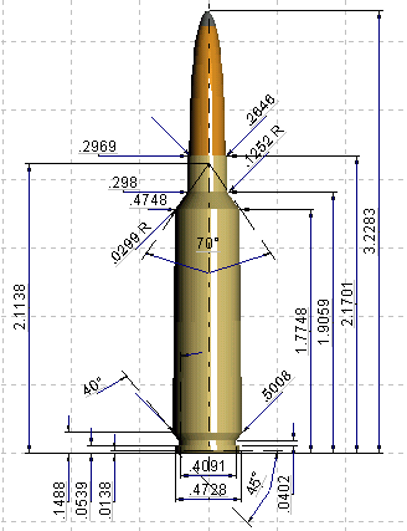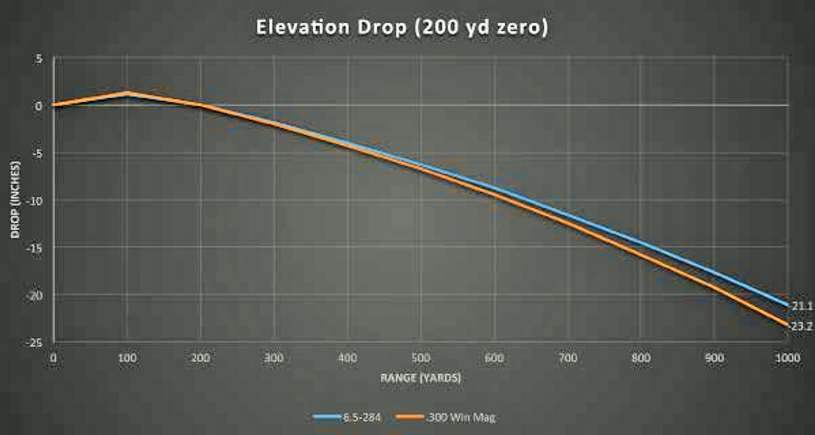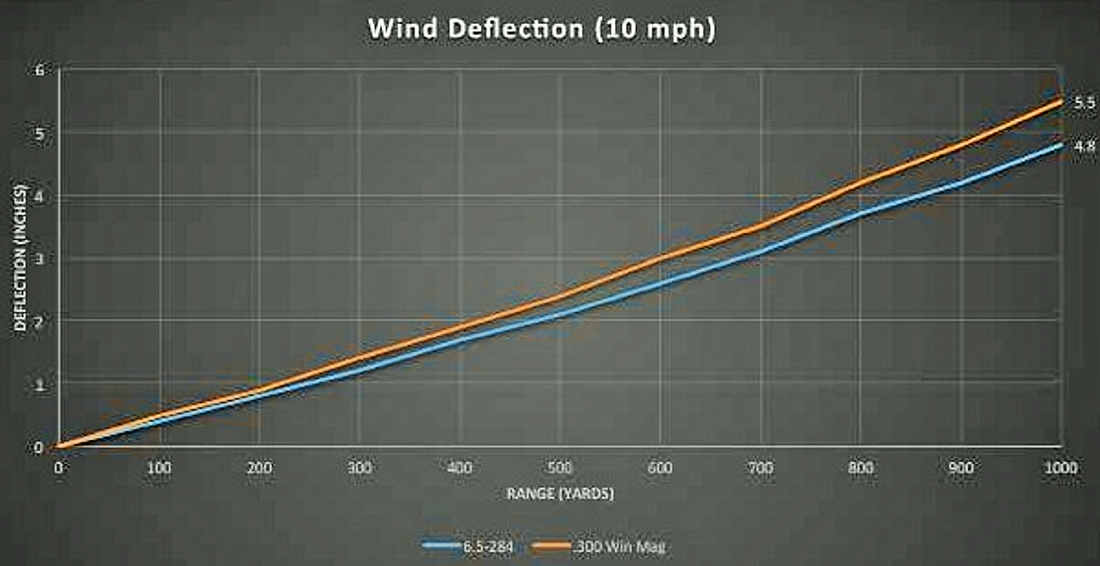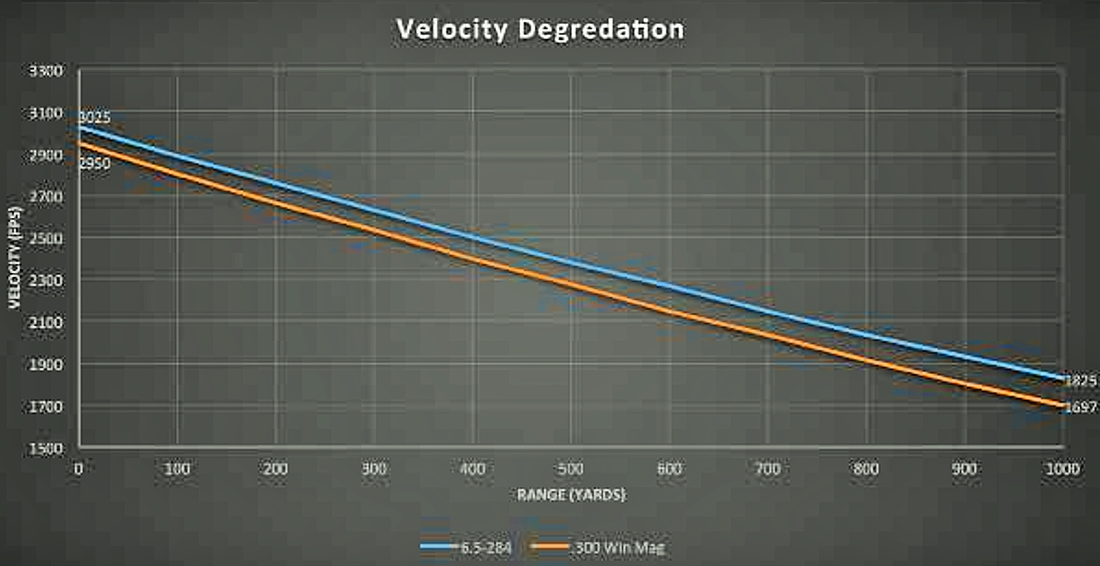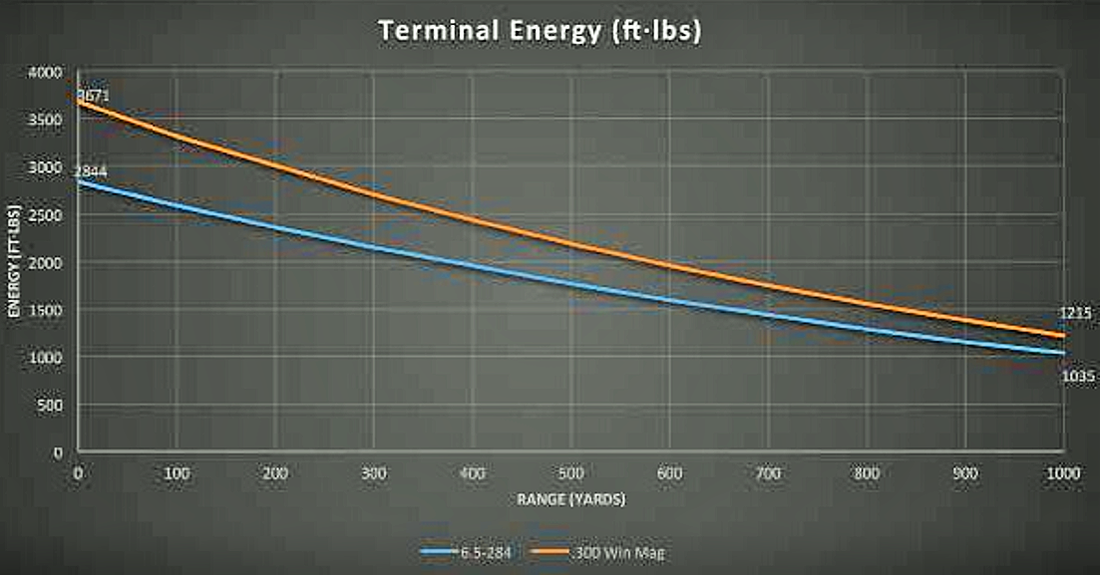The 6.5-284 Norma, popular among long range match shooters, has become one of Gunwerks’ favorite long range hunting cartridges. By the end of this article, you’ll be thinking good and hard about making this your next favorite round, and I may have a handful of wives (and hopefully the husbands of all you awesome ladies out there in the hunting and shooting industry) angry with me for convincing you that you need another very important rifle, “critical to your continued success in the field.” Feel free to state it that way too, but please leave my name out of it. If you need to point blame, point to the science I’m about to share with you because it’s hard to argue the facts.
The evolution of the 6.5-284 is not all that different from many other cartridges. It began as a new factory cartridge turned wildcat, turned standard. Originating in 1963 as the .284 Winchester, it was originally designed as a 7mm hunting round intended to match the ballistics of a .270 but in a shorter case. Winchester was very successful in this endeavor, but as with many new things, it didn’t take root for one reason or another.
In come the wildcats, and this original spawned many. A quick internet search will introduce you to all the various cartridges born of the .284 Win, so I will focus on the remainder of this article on one of the most popular, the 6.5-284 Norma. After demonstrating great success, the 6.5-284 was submitted by Norma in 1999 to the CIP (Permanent International Commission of Firearms Testing) for standardization. It has been used to set multiple long range precision records.
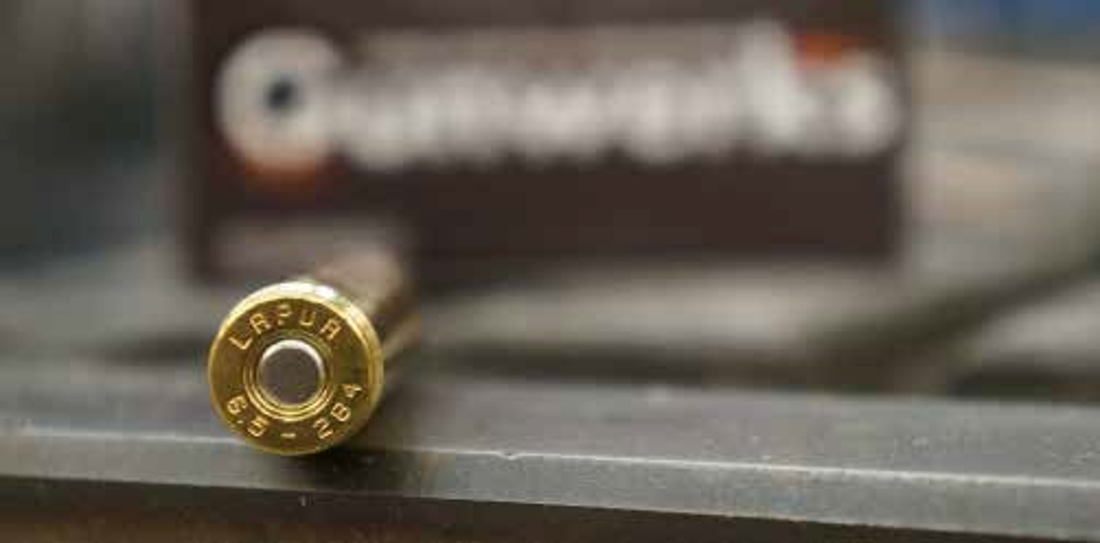
When it comes to recipes, there are two main approaches you can take: 1) Gather a myriad of components, put them together in a few different combinations, and do all the testing yourself to determine which combination provides the desired result, or 2) Buy loads from a manufacturer who has done all of that themselves. If you’re of the former make and model, there’s a very good chance you know what you’re doing and have your own preferred method of load development. I will not take this opportunity to dive deep into load development methodology. Suffice it to say there are a multitude of acceptable powders and bullets to choose from. When it comes to brass, the choices are more limited to Lapua, Norma, and Hornady, as well as continuing to neck down the .284 Winchester brass.
Gunwerks spends a lot of time developing optimum loads for our customers. When it comes to long range load development, we sort of know what we’re doing. I encourage you to try our 6.5-284 Norma before you spend the time and money to develop a load yourself. I think you’ll be more than happy with the performance. We load using Lapua brass, Federal 210 primers, and Retumbo powder. Top it with a 140 gr Berger VLD touting a BC of 0.612 (0.313 G7) and you have a round that travels 3025 fps out of a 26″ 1:8 twist barrel: a winning combination.
Neck and chamber diameters are always an important topic. This is vastly more important when competition shooting, and I believe there are as many opinions as there are possibilities. Clearance between the neck and chamber diameters vary anywhere from around 0.0015″ up to 0.004″ or greater. Ultimately, it comes down to the individual shooter’s preferences and tendencies, as multiple factors play into long range shooting beyond just the cartridge characteristics. It’s the summation of all those factors that makes the shot successful, and each person has to figure out his own magic combination.
For a hunting cartridge, more clearance is typically desirable. Gunwerks chambers rifles with a 0.299 diameter reamer. Loaded brass measures 0.294″ giving a 0.005″ clearance. We find this the optimum combination for long range hunting with our factory cartridge at this time. This is also the cartridge build we use at our Long Range University training courses. Shooters love it.
Now for the most important stuff (and by far the most enjoyable part)—performance. That’s what it all comes down to, right? There are a hundred different ways to build a cartridge, but if it doesn’t perform as desired, what does it matter? To a hunter, how do we measure performance? I propose the simplest measurement of performance is seeing an animal on the ground. So what does it take to put an animal down? Let’s explore.
I don’t think it’s outrageous to claim that most people believe that Kinetic Energy (ft·lbs) is the most important factor in killing power. Additionally, many people think that the bigger the caliber and heavier the bullet the better the results will be. I totally disagree, and I think you’ll see why. Don’t get me wrong. I believe in Kinetic Energy. Work requires energy, and it is work for a bullet to tear through an animal’s skin, meat, and bones in pursuit of damaging its vital organs. Kinetic Energy is very important and a good, general indicator of killing power, but it’s not the most important.
To kill an animal, a bullet must damage vital organs—heart, lungs, nervous system, etc. Bullet placement is the most important factor in hunting performance success. In other words, the ability of the system (the hunter, the rifle, the cartridge) to place the bullet in the vitals. Let’s break this down into subcategories: Sectional Density of the Bullet, Elevation Drop, Wind Deflection, Velocity Degradation, Terminal Energy, and Human Factors.
There’s quite a buzz surrounding .30 caliber cartridges for long range shooting, including use as sniper rifles in militaries around the world. To illustrate the benefits of the 6.5-284, I’ve chosen to compare it to the .300 Win Mag, both Gunwerks loads. Here’s the information below:
CARTRIDGE: 6.5-284 NORMA
BULLET: 140 GR VLD
BC: 0.612
MV (FPS): 3025
CARTIRIDGE: .300 WIN MAG
BULLET: 190 GR VLD
BC: 0.57
MV (FPS): 2950
SECTIONAL DENSITY
Chuck Hawks has a really good article on the importance of sectional density. This is the ratio of the weight of the bullet in pounds to the square of the diameter in inches. Bullet profile doesn’t matter for calculating sectional density, although bullet design matters when it comes to what it does when it hits an animal, a discussion for another day. To sum things up, the higher the sectional density a bullet has, the better the penetration, or the easier the bullet is able to get deep inside the animal. When it comes to putting animals on the ground, the bullet must reach the vitals. The section density of the 6.5mm 140 gr VLD is 0.287 and the .30 cal 190 gr VLD is 0.286, nearly identical. Remember, sectional density translates to penetration power.
ELEVATION DROP
This is the result of gravity pulling the bullet into the earth. As all things on earth do, bullets drop vertically at a constant rate. I plugged both of the cartridge’s information into Gunwerks’ Ballistics Calculator found at www.gseven.com using a 200 yard zero, and here is the result. As shown in this graph at the bottom of this page, the 6.5-284 drops 2.1″ less at 1000 yards than the .300 Win Mag. Similar results, but the 6.5-284 has a slightly flatter trajectory.
WIND DEFLECTION
As Elevation Drop is the vertical displacement of the bullet, Wind Deflection is the horizontal displacement of the bullet. This is how far a bullet travels left or right from its original trajectory in response to how the wind is blowing on it, altering its path. For ease of demonstration, I chose to use a 10 mph wind to compare these two cartridges. As we see from this graph, (above) wind affects the larger .300 Win Mag more than the smaller 6.5- 284 to the tune of 0.7″ at 1000 yards. Again, pretty close to each other, but slightly better performance out of the 6.5-284.
VELOCITY DEGRADATION
This analyzes how fast a bullet loses velocity over distance. Granted, the two cartridges start at slightly different velocities, 3025 fps for the 6.5-284 and 2950 fps for the .300 Win Mag respectively. However, muzzle velocity is derived by the ability of the cartridge to withstand chamber pressures and the ideal velocity to produce a stable bullet. It’s a sound comparison. Over 1000 yards, the 6.5-284 loses 1200 fps compared to 1253 fps lost by the .300 Win Mag. Once again, very similar, but the title goes to 6.5-284. If you’re keeping count, that’s 6.5-284 – 3, .300 Win Mag – 0.
TERMINAL ENERGY
All of this (sectional density, elevation drop, wind deflection, and velocity degradation) comes together in Terminal Energy, or Kinetic Energy at target. Take a look at the graph below. No surprise the .300 Win Mag starts at a much higher energy level than the 6.5-284. Over 1000 yards, however, the 6.5-284 only loses 1809 ft/lbs of energy compared to the .300 Win Mag’s 2456 ft/lbs. We can make a few points of comparison from these results. First, how the bullet performs after striking its target, how it expands or breaks apart, will be more consistent from 0-1000 yards for the 6.5-284 than the .300 Win Mag meaning bullet selection is far more important for the latter because it has to come apart the same way over a much bigger energy profile. Second, there is and maintains to be more Terminal Energy in the .300 Win Mag, but don’t get caught up saying “see, I told you so” just yet. Wait and read my conclusion. Third, at 1000 yards, the Kinetic Energy of both bullets is over 1000 ft/lbs. Chuck Hawks tells us in his article “The Killing Power of Big Game Bullets” that, “It is generally recommended that a small bore (.24-.32 caliber) rifle bullet suitable for medium size (CXP2 class) game be carrying about 800 ft/lbs of kinetic energy when it hits.” From this analysis we can see that both cartridges are legitimate 1000 yd hunting rifles. In fact, the 6.5-284 doesn’t drop below the 800 ft/lbs mark until after 1200 yds, the .300 Win Mag after 1300 yds. As always, practice ethical hunting within your own personal limitations and capabilities. A responsible hunter always strives for a one shot kill.
HUMAN FACTORS
Prior to terminal velocity, the score was 3-0 in favor of 6.5-284. I have my opinions on the rank of importance of terminal velocity and could make an argument for weighting that category, but taking it at face value, I’ll swallow my opinions and call it 3-1. The last category has to do with human factors. There are a number things that play into this category, and I don’t have time to get into them all, but in the spirit of comparison, let’s only consider what is different from the two cartridges. I may be missing something, but to me, the biggest human factor difference in the two is recoil. It’s no secret that a .300 Win Mag kicks much harder than a 6.5-284. Most people probably know that even if they haven’t shot both. I could go into the math, but that’s outside the scope of this article. Suffice it to say, I’ve run the calculations on a Gunwerks LR1000, 9.75 lb rifle. Free recoil, not to be confused with felt recoil which differs for each person, of the 6.5-284 is 13.97 ft•lbs compared to 23.84 ft•lbs of the .300 Win Mag, nearly half. Anyone who tells you recoil doesn’t affect their ability to shoot doesn’t understand the physics of shooting and the effects of that recoil on the subconscious. I brace myself far more for my .300 Win Mag consciously and subconsciously than any other gun I have. It’s real, and who in their right mind wouldn’t rather shoot a gun that kicks less? Score = 4-1.
CONCLUSION
The 6.5-284 is one of my favorite, versatile cartridges to shoot, and the ballistics prove it to be a legitimate long range hunting rifle to take to the field. When it comes down to performance, the biggest factor in successfully filling your tag is accuracy. It’s all about your ability to put the bullet on the vitals, and I’ve proven the ability of this cartridge to penetrate and destroy vitals on a big game animal out to 1000 yards.
When you put a winning system together, one where the rifle, scope and cartridge are built in complement of each other, the only thing standing in your way of success is you. The 6.5-284 has taken countless animals around the world. It’s a proven cartridge, time and time again, and if you’ve never had the opportunity to shoot one, it’s worth the effort to find one to shoulder. It is such a pleasant and enjoyable experience.
So guys and gals, now that you have a reason to go out and get your next rifle (not that you really needed an excuse for another gun in the case), seriously consider the 6.5- 284. When it’s time to have “the talk” with your significant other, show them the facts… Just don’t tell them where you got them.
Editor’s Note:
There are few topics in hunting and shooting as hotly debated and discussed as rifle and caliber selection. For this reason, highly objective, science based article’s like Danen’s are especially insightful for those of us that want to truly understand long range ballistics. We’d like to thank Gunwerks for allowing us to re-publish an article we felt made us think outside the box of a typical ballistic comparison.
Gunwerk’s Long Range Magazine is without question one of the premiere hunting and shooting publications available today. To find out more about their premium hunting and adventure magazine go to www.longrangeoutfitters.com.


